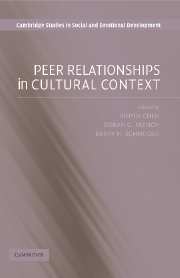Book contents
- Frontmatter
- Contents
- List of Contributors
- Introduction
- Part I Culture and Peer Relationships: Theoretical and Methodological Issues
- Part II Temperamental and Emotional Influences on Peer Relationships
- Part III Peers and Parents
- Part IV Peer Interactions and Social Behaviors
- Part V Friendships
- 17 Friendships of Indonesian, South Korean, and U.S. Youth: Exclusivity, Intimacy, Enhancement of Worth, and Conflict
- 18 The Cultural Practice of Close Friendships Among Urban Adolescents in the United States
- 19 Latino-Heritage Adolescents' Friendships
- 20 The Cultural Context of Children and Adolescents: Peer Relationships and Intimate Friendships Among Arab and Jewish Children in Israel
- Commentary III
- Conclusion
- Author Index
- Subject Index
- References
17 - Friendships of Indonesian, South Korean, and U.S. Youth: Exclusivity, Intimacy, Enhancement of Worth, and Conflict
from Part V - Friendships
Published online by Cambridge University Press: 08 August 2009
- Frontmatter
- Contents
- List of Contributors
- Introduction
- Part I Culture and Peer Relationships: Theoretical and Methodological Issues
- Part II Temperamental and Emotional Influences on Peer Relationships
- Part III Peers and Parents
- Part IV Peer Interactions and Social Behaviors
- Part V Friendships
- 17 Friendships of Indonesian, South Korean, and U.S. Youth: Exclusivity, Intimacy, Enhancement of Worth, and Conflict
- 18 The Cultural Practice of Close Friendships Among Urban Adolescents in the United States
- 19 Latino-Heritage Adolescents' Friendships
- 20 The Cultural Context of Children and Adolescents: Peer Relationships and Intimate Friendships Among Arab and Jewish Children in Israel
- Commentary III
- Conclusion
- Author Index
- Subject Index
- References
Summary
Friendships, although generally conceptualized as voluntary associations between individuals, invariably occur within a cultural context. McCall (1988) argued that friendships are institutionalized, and that individuals are guided by cultural blueprints, which may specify persons who can and cannot be friends, the types of interactions that friends expected to have, and the emotional connectedness that friends are typically experience (see Bigelow, Tesson, & Lewko 1996, for a similar analysis). Participants in the friendship as well as others observing this friendship may experience tension if the friendship deviates from these blueprints. Unfortunately little attention has been devoted to understanding the cultural context within which friendships exist in part because anthropologists have paid limited attention to this subject (Bell & Coleman, 1999).
In this chapter, we review our research on the friendships of Indonesian, Korean, and U.S. youth in an effort to understand cultural variation in these relationships. We begin with a discussion of friendship in Indonesia, Korea, and the United States, followed by a brief review of some of the methodological underpinning of our work. We then focus on understanding cultural differences in the structure of friendship by exploring friendship exclusivity, which is the extent to which close friendship groups are open to inclusion of others. In the next section, we present our work on the characteristics of relationships across cultures, specifically focusing on provisions (i.e., intimacy and enhancement of worth), longevity, and conflict.
- Type
- Chapter
- Information
- Peer Relationships in Cultural Context , pp. 379 - 402Publisher: Cambridge University PressPrint publication year: 2006
References
- 16
- Cited by

